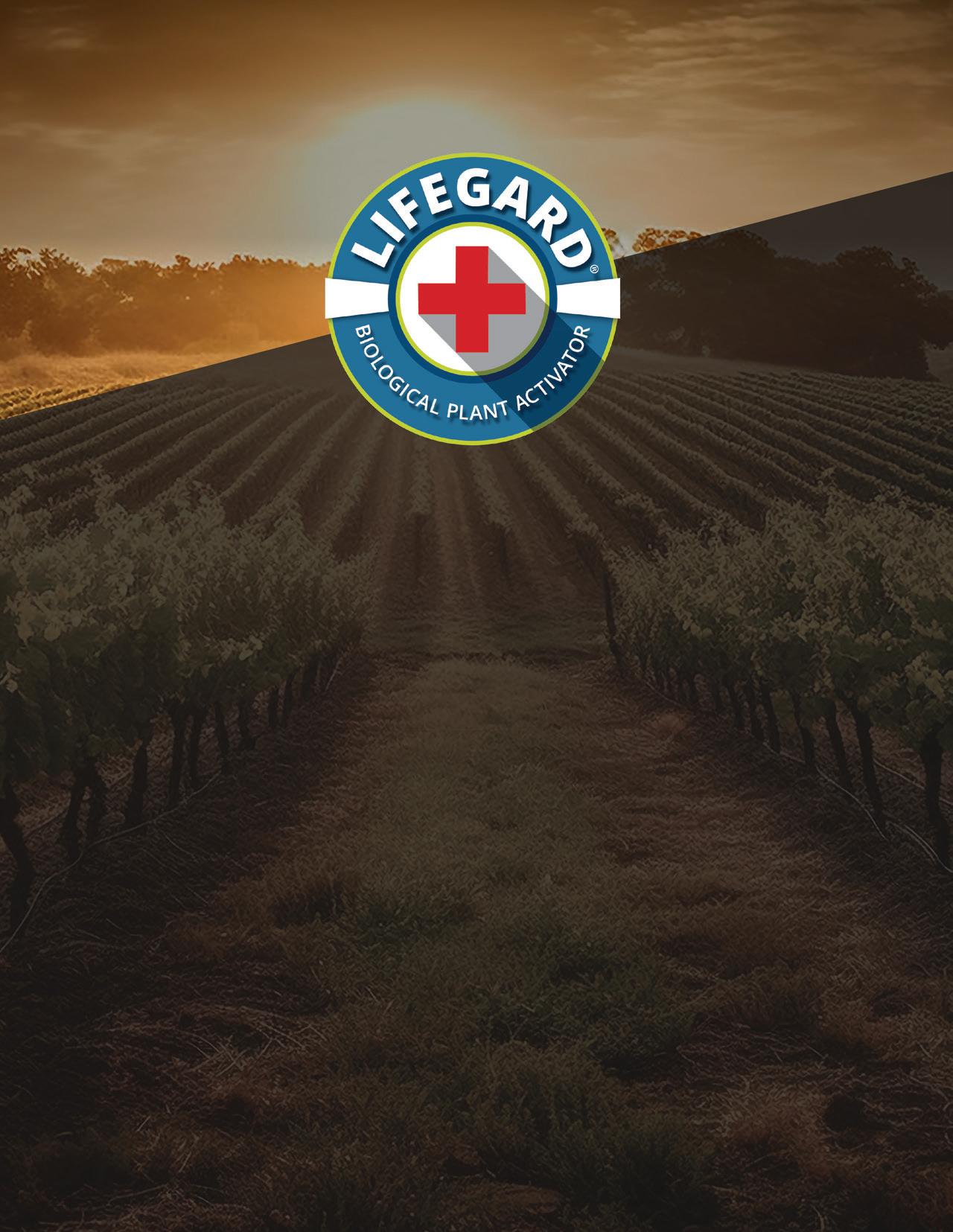







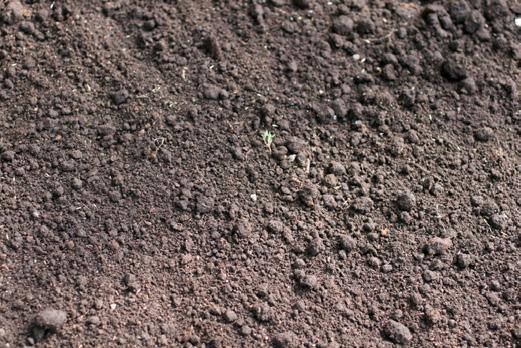














‘TOUCH-FREE’ VINEYARD PROVED CONCEPT
PUBLISHER: Jason Scott
Email: jason@jcsmarketinginc.com

EDITOR: Taylor Chalstrom
Email: article@jcsmarketinginc.com
PRODUCTION: design@jcsmarketinginc.com
Phone: 559.352.4456
Fax: 559.472.3113
Web: www.grapeandwinemag.com
CONTRIBUTING WRITERS & INDUSTRY SUPPORT

TIPS FOR MANAGING VINE NUTRITION IN VINEYARDS
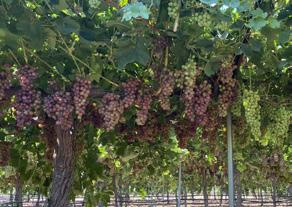
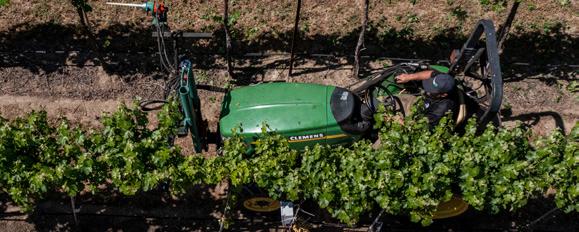
NUTRITIONAL AND INGREDIENT LABELING CHANGES FOR U.S. WINE EXPORTERS TO EUROPE
SUSTAINABLE STORY SERIES: PART 1
WINERY FEATURE: SMITH-MADRONE VINEYARDS
THE BIOPESTICIDE REVOLUTION: OPPORTUNITY KNOCKS FOR GROWERS AND INVESTORS
Surendra Dara Director, North Willamette Research and Extension Center
Kevin Day UCCE Pomology Farm Advisor, Tulare and Kings Counties
Elizabeth Fichtner UCCE Farm Advisor, Kings and Tulare Counties
Katherine Jarvis-Shean UCCE Orchard Systems Advisor, Sacramento, Solano and Yolo Counties
2023 www.grapeandwinemag.com
The articles, research, industry updates, company profiles, and advertisements in this publication are the professional opinions of writers and advertisers. Progressive Crop Consultant does not assume any responsibility for the opinions given in the publication.



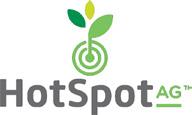



7:00 AM BREAKFAST & TRADE SHOW
JOINT DPR & CCA TRACK
8:00 AM
Neighborly NOW Program: Getting Connected with Mating Disruption Users
Jesse Roseman, Principal Analyst, Almond Board of California
8:30 AM
Pesticide Roadmap Panel: What Does the Future of Pesticide Use Look Like for California?
Renee Pinel, President/CEO, Western Plant Health Association; Surendra Dara, NWREC Director and Professor, Oregon State University; Roger Isom, President, WAPA; Daniel Hartwig, Director of Sustainability, Woolf Farming
9:30 AM
Industry Talk: Iodine as a Plant Nutrient
Doug Snyder, Business and Marketing Development Manager, SQM North America
10:00 AM TRADE SHOW & BREAK
10:30 AM
Laws and Regs Workshop: What We Learned from Top Pesticide Violations in 2022

Rigo Ceja, Outreach and Training Specialist, Ag Safe
11:00 AM
Industry Talk: Growing Large, High-Quality Fruit Through Nutrition
Jeff Merrit, CEO, Axiom Ag
11:30 AM
Biopesticides: Where Industry Stands
Surendra Dara, NWREC Director and Professor, Oregon State University
12:00 PM LUNCH
Special Guest Entertainment: Jeff Applebaum
DPR TRACK
Tackling Pesticide Resistance of Spotted Wing Drosophila
Jhalendra Rijal, UCCE Area IPM Advisor, Stanislaus County
Overview of SensorControlled Sprayers and Sprayer Types
Brent Warneke, Faculty Research Assistant, Oregon State University
Soilborne Diseases in Vegetable and Tomato Row Crops
Tom Turini, UCCE Vegetable Crops Farm Advisor, Fresno County
The Role of Mating Disruption in Vineyard Pest Management
Kent M. Daane, UCCE IPM Specialist, UC Berkeley, Kearney Agricultural Research and Education Center
1:30 PM 2:00 PM 2:30 PM 3:00 PM 3:30 PM TRADE SHOW & BREAK
CCA TRACK Regenerative Almond Management
Jessica Chiartas, Ph.D., California Soil Resource Lab, UC Davis
Almond Carbon Footprint and Soil Health
Devin Clarke, Permanent Crop Manager, Yara International
Nutrition and Soil Health Panel
Karl Wyant, Director of Ag Science, Nutrien; JW Lemons, Account Manager, Verdesian; Jerel Kratt, CEO, Regenerative Crop Consulting, Inc.; Matt Comrey, South Sacramento
Valley Sales Manager, Wilbur-Ellis
Continued
4:30 PM
Bringing Fresh Perspectives to Combat Lettuce Disease
Kirsten Pearsons, UCCE IPM Advisor; Yu-Chen Wang, UCCE Plant Pathology Advisor, Santa Cruz, Monterey and San Benito counties
Thursday, September 28
7:00 AM BREAKFAST & TRADE SHOW
JOINT DPR & CCA TRACK
8:00 AM
Biostimulant Panel: Plant Biostimulant Act Reintroduction
Russell Taylor, Vice President, Live Earth Products; Kirk Van Leuven, CCA/PCA, Stoller USA; Rich Kreps, CCA, SSp., Ultra Gro; August York, CCA, Intuit Ag Consulting; James Henderson, CCA, President, Prime Dirt, Inc.
DPR TRACK
Hydrogel Bait for Sugar-Feeding Ants in Vineyards
David Haviland, UCCE Area IPM Advisor, Kern County
9:00 AM
CCA TRACK
Groundwater Recharge On-Farm vs InfrastructureLarge-Scale Eryn Wingate, Agronomist, Tri-Tech Ag Products
9:30 AM
Industry talk
Multicolor Ecological Agriculture Inc.
10:00 AM TRADE SHOW & BREAK
Preparing for Disease in Future Cool, Wet Years
Themis Michailides, Plant Pathologist, UC Davis
Citrus Red Scale: Research Updates, How This Year's Weather Affected Insect Generations
11:00 AM 11:30 AM
Sandipa Gautam, UCCE Area Citrus IPM Advisor, Tulare County
Capturing Runoff with Product Technology Eileen Bernard, Adjuvants Manager, Nutrien Ag Solutions
Stress Management in Agronomic Crops in the South West Phil Frost, Technical Development Manager, Verdesian Life Sciences
12:00 PM LUNCH
Presentation of WRCCA’s CCA of the Year award, Scholarships and Honorariums
1:00 PM Industry Talk
Heritage Crop Science, LLC
1:30 PM
Beet Leafhopper Management in Processing Tomatoes
Zheng Wang, UCCE Vegetable Crops and Irrigation Advisor, Stanislaus County
2:00 PM
Personal Protective Equipment Required by Labels for Employees and Owners
Judy Brant, Agricultural Inspector, Tulare County Ag Commissioner Office
2:30 PM ADJOURN
Soil pH Nutrient Availability Table: Where did it come from and how to use it?
Danny Klittich, Director of Agronomy, Mission Produce, Inc.
Register Today:
Prompted by labor availability and ever-increasing labor costs, winegrape growers have increasingly turned to mechanization, first with harvest and then with other cultural practices.
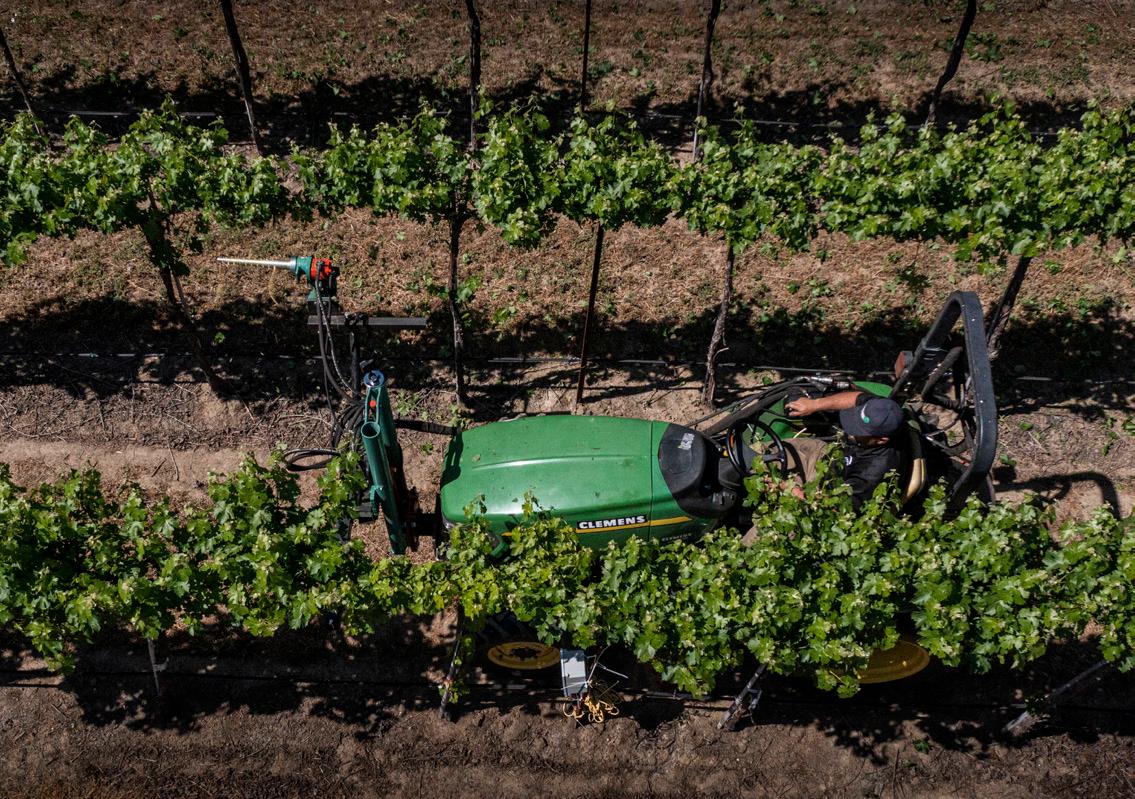
The move didn’t come overnight and has been more of an evolution, said S. Kaan Kurtural, founder of Kurtural Vineyard Consulting in Davis, Calif. In addition, a fully mechanized production system isn’t for every grower, and they must weigh their production practices before making the jump.
But Kurtural has proven it can be done, whether growers are planting a new vineyard or wanting to convert over an older one.
For more than 20 years, he has studied mechanized winegrape production first at California State University, Fresno, and then at UC Davis, until earlier this year. One of the most recent projects he led was establishing a “touch-free” experimental winegrape vineyard at the UC Davis Oakville Station.
“15 years ago, there wasn’t a lot of economic necessity to do mechanized practices,” Kurtural said. “However, grape prices have not changed in the last 25 years. Now it’s become a necessity, and there’s been a change in the ways vineyards are planted and farmed.”
Controlling labor costs has become a focus as state minimum wages increase annually. That’s because labor tied to pruning and harvesting account for
more than 80% of overall vineyard labor costs, according to research conducted by Kurtural and several colleagues.
George Zhuang, UCCE viticulture advisor in Fresno County, conducted four studies in 2019 that estimated the costs and returns of establishing and producing winegrapes in the southern San Joaquin Valley. The research, which looked at nearly complete mechanization, involved four varieties: cabernet sauvignon, chardonnay, rubired and colombard.
Based on the studies, fully implemented mechanization reduced production costs from $3,000 to $2,500 per acre, or 17% less.





Because the studies were completed four years ago, Zhuang said he couldn’t help but expect the savings to be even more today with the state’s annual increase in minimum wage.
“If you still use my numbers, the savings have jumped from $500 to at least $700,” he said.
Aiding the transition are the growing number of U.S. equipment manufacturers that have developed machines to box prune vines in one pass, Kurtural said. Many European machines, on the other hand, are designed more for the VSP (vertical shoot-positioning) trellis system and only prune on one plain.

Choosing the proper trellising that provides 360-degree machine access without cross arms or wires getting in the way is key to making full mechanization successful, Kurtural said.
Other factors to consider include topography, cultivars, rootstocks, vine and row spacing, irrigation systems, climate and yield potential. Cultivars that can be trained to have straight trunks and
lateral cordons lend themselves to mechanized management. In addition, those with strong basal bud fruitfulness, such as chardonnay and cabernet, are better suited to mechanized management than varieties like Thompson seedless with lower basal bud fruitfulness.
In several trials, the single high wire trellis system performed the best, reducing labor costs by more than 90% and increasing fruit yields without reducing quality. Known by other names, including high-cordon machine pruned, the system involves training bilateral cordons on a single wire about 60 to 72 inches off the vineyard floor. Canes are allowed to flow over the sides to create a kind of parasol over the fruiting zone. The leaves don’t totally block the sun, instead acting like a sun screen to filter rays that hit the fruit.
The single-wire system isn’t far removed from the California sprawl, where bilateral cordons are topped by a single catch-wire, and canes are allowed to sprawl over the sides to create a canopy covering the fruiting zone. Where the single-wire system differs is it lacks extraneous wires that may interfere with mechanical pruning blades, saws or sickles.
The single-wire system also elevates fruit higher off the vineyard floor, minimizing damage from spring frosts that are colder closer to the ground. Recent UC research led by Kurtural also has found the system protects fruit from heat waves or increasing temperatures by keeping it farther away from heat radiating from the vineyard floor.
The VSP system, on the other hand, uses a fruiting wire about 36 to 40 inches from the ground. Three to five additional movable wires allow for shoot training. The fruit is exposed to the sun, making it prone to sunburn. The lower fruiting wire also makes buds and new leaves more susceptible to spring frosts.
While the California sprawl system works for mechanization, cross arms with two catch wires can cause big problems for mechanical pruning or shoot thinning.
In addition, the single-wire system typically helps balance canopy size with fruit load without affecting grape quality. In fact, Kurtural said, the new systems actually enhance desirable chemical components such as anthocyanins within the fruit.
“We initially started work to see if [full mechanization] would be economically profitable for the grower,” he said. “Once we established that, we noticed that the quality was much higher at the farm gate. In the end, the wine was preferred by taste panels as well.”
Along with harvest, dormant pruning is one of the most labor-intensive and costly cultural practices tied to winegrape production, according to Kurtural’s research.
Over the years, he and his colleagues have found that mechanized box pruning, where bearing spurs are pruned from the top, bottom and sides, mostly closely resembles hand pruning. The initial prepruning pass leaves a box with dimensions ranging from about 4 to 6 inches wide and about 4 inches tall.
Because mechanical pruning is not
selective, follow-up mechanical shoot thinning after bud break and the danger of frost has passed helps achieve the desired shoot density

Zhuang, who cooperated with Kurtural in some of his previous trials, said nearly all new vineyards being planted in the south San Joaquin Valley are on single high-wire trellises.
“It’s very obvious right now based on my observations that all of the new plant ings of winegrapes are on single wire or high quads shooting for 100% mechani cal pruning,” Zhuang said.

Because yield is the top goal of south

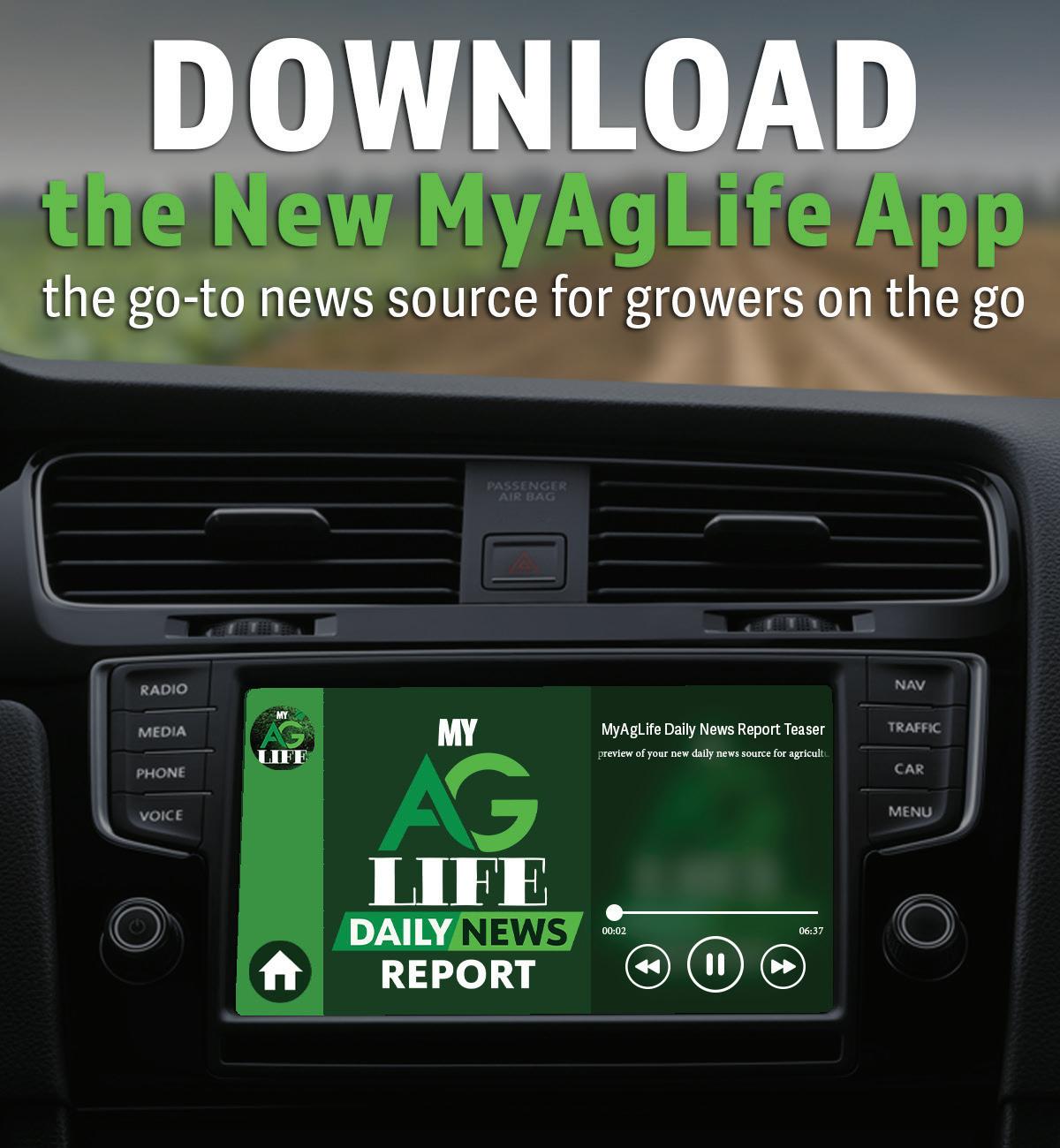
San Joaquin Valley vineyard to mechanization. The 20-year-old head-trained merlot vineyard was planted on traditional trellising that involved two eight-node canes laid on a catch wire in opposite directions and two eight-node canes attached to a 66-inch-high catch wire. Although the system could be mechanically harvested, it didn’t lend itself to mechanical dormant pruning or shoot removal.
the project was completed, the vineyard owner converted the remaining 45 acres of vines to the single high-wire system.
But Zhuang said there is a caveat when converting vines to a new trellis system.
“We see a lot of those old vineyards in the south San Joaquin Valley have a lot of trunk disease, so there’s a lot of dead arms,” he said. “Typically, we don’t recommend growers convert those vines and Eutypa will come back and impact
But if the vineyard is relatively healthy without a lot of dead arms, Zhuang said it would be a good candidate for conver-
In the world of cybersecurity, they’re called “bad actors,” and they’re not just attacking corporate giants, retail chains and school systems. They’re targeting ag-related businesses too.
Criminal hackers are looking to breach your network, steal your data and compromise your operations. They can hold you hostage, denying you access to your own files unless you pay a hefty ransom. It’s not a question of if but when a cybercrime will occur, experts warn.
“It doesn’t matter what the business is or its size, the threats are very real,” said Doug Davidson, director of technology for GBQ, which Forbes lists as one of America’s Best Tax and Accounting Firms. “Today, 25% of all crime is cyber-related.”
Is your farm or winery vulnerable?
If your business uses email or smartphones, it is. If your employees handle payroll, inventory, shipments and customer transactions online, it is. If your wine club conducts business via the internet, you’re at risk. In fact, anything attached to the internet is vulnerable to a cyberattack.
The primary motivation for attacks continues to be overwhelmingly financially driven at 95% of breaches, reported Verizon in its widely read 2023 Data Breach Investigations Report. It also noted the most common form of attack
is ransomware, followed by business email compromise (BEC).
“Ransomware continues to be a major threat for organizations of all sizes and industries,” said Verizon.
The three primary ways in which attackers access an organization are stolen credentials, phishing and exploitation of vulnerabilities, the report added.
As vineyards and wineries increase their use of technology, they must be aware of the security controls they have in place, said Melissa DeDonder, senior manager and director of external IT consulting for Pinion, a national food and ag consulting and accounting firm.


As examples, she pointed to chemical applications in the field, temperature settings during fermentation, humidity in warehouses, all increasingly controlled by automation. Further, there’s third-party risk, where processes such as sales orders and distribution are handled through digital avenues. A customer relationship management system, with customer names, addresses, phone numbers and credit card information, is also vulnerable.
“Can your system be broken into?” DeDonder asked. “What are the risks or breaches that can happen there? How are you securing that data?”
As online hackers get more sophisticated, prevention and protection are critical to the grape
Writer“My No. 1 cyber protection advice is to educate your employees,” says Pinion’s Melissa DeDonder (photo courtesy Pinion.) Ransomware and business email compromise usually happen because people click on a malicious link or PDF file (photo by C. Merlo.)
There are several layers of cybersecurity, but the most basic prevention starts with recommendations from the Cybersecurity and Infrastructure Security Agency, the nation’s cyber defense agency and national coordinator for critical infrastructure security.
“Using strong passwords, updating your software, thinking before you click on suspicious links and turning on multi-factor authentication are the basics of what we call ‘cyber hygiene’ and will drastically improve your online safety,” CISA said. “These cybersecurity basics apply to both individuals and organizations.”
Beyond that, business owners should
know what software, hardware and important data they have. That includes computers, printers, routers, security cameras and smartphones.
“We find that most organizations don’t know what they have or where it is,” said GBQ’s Davidson. “If you don’t know what you have, you can’t protect it.”
Another cyber defense is to back up data regularly, FBI agent Brad Swenson told attendees during a “Cybersecurity 101” seminar at World Ag Expo in Tulare, Calif. last February.

“Keep three copies of your data,” Swenson said. “Two of them onsite should be on two different computers, so if one crashes, you still have another. One copy
should be out in the cloud or offsite. You can put it on a hard drive and put it in a safety deposit box at the bank.”
Swenson also urged people to be careful about what they post online. Bad actors
”
My No. 1 protection advice is always to educate your employees. Ransomware and BEC happen because employees, executives or owners click on something.” -- Melissa DeDonder, Pinion
“use that information against you,” he said. “They do their research, figure out who you are, what makes you tick, then use it against you.”
Businesses should also fight cybercrime by adopting a security framework, Davidson said. He likens that to a playbook of controls put in place to identify what you have and what needs to be done to protect it.

One available framework comes from the National Institute of Standards and Technology (NIST). This government agency has developed the Cybersecurity Framework to enhance the security and resilience of the nation’s critical infrastructure. The framework integrates a set of industry standards and best practices to help organizations manage cybersecurity risks. It’s free and accessible at nist. gov/cyberframework.

Unfortunately, businesses’ biggest cyber threat often lies close to home. Verizon’s 2023 report found that 74% of all breaches include “the human element,” with people being involved either through error, privilege misuse, use of stolen credentials or social engineering.
For many businesses, that weak link is employees, especially those who unknowingly click on a link or open a PDF file that contains malware, or malicious software, which allows hackers in.

“My No. 1 protection advice is always to educate your employees,” said Pinion’s DeDonder. “Ransomware and BEC happen because employees, executives or owners click on something.”
Cybersecurity training teaches people what to watch out for, whether it’s a malicious email link, PDF file or website. And once-a-year training isn’t enough, added DeDonder.
“It’s got to be constant and repetitive.”
Among other cyber-hygiene practices DeDonder advocates are patching, or updating, your system and backing up critical data you and your business can’t afford to lose. Then test your online security controls that are in place.
“And make sure you have enough of a technology budget to protect your business,” she said.
If your system has been compromised, you should contact the FBI, according to Swenson. He advised victims to start with the FBI’s Internet Crime Complaint Center at www.iC3.gov. The site offers a complaint form that, once filled out, will be routed to the appropriate FBI field office so the agency can start taking action.
If a cybercrime involves a financial theft, “the quicker you can notify us, the quicker we can take action to stop that money movement,” Swenson said. “If you let us know within 72 hours of a fraudulent wire transfer, we have mechanisms in place to halt it. In the instances I’ve seen, the money gets returned.”
While Davidson recommends anyone who’s had a cybercrime event to report it to the FBI, he believes the first person you should call is your attorney.
“An attorney can help do some of the investigative work under privilege,” he said. “Then call your insurance carrier if you have cyber liability insurance.”
Bottom line: Be suspicious. Be careful what you download and what you share. Make sure your business has controls in place to detect, respond to and recover from a cyber threat or actual event. Don’t let bad actors catch you unprepared.
Hacking: Attempts to intentionally access or harm information assets without authorization by circumventing or thwarting logical security mechanisms.
Ransomware: A type of malicious software that threatens a victim by destroying or blocking access to critical data or systems until a ransom is paid.
Business email compromise: A type of cybercrime where the scammer uses email to trick someone into sending money or divulging confidential company information.
Spoofing: When someone disguises an email address, sender name, phone number or website URL, often just by changing one letter, symbol or number, to convince you that you are interacting with a trusted source.
Phishing: A targeted attempt to obtain sensitive data by duping victims into voluntarily giving up account information and credentials.
Data Incident: A security event that compromises the integrity, confidentiality or availability of an information asset.
Data Breach: An incident that results in the confirmed disclosure (not just potential exposure) of data to an unauthorized party.
Malware: Any malicious software, script or code run on a device that alters its state or function without the owner’s informed consent.
Sources: Verizon’s 2023 Data Breach Investigations Report; FBI.gov; Microsoft. com
The FBI is the lead federal agency for investigating cyberattacks and intrusions. Here are some tips the FBI offers to protect yourself from cybercriminals: Keep systems and software up to date and install a strong, reputable anti-virus program.
Be careful when connecting to a public Wi-Fi network and do not conduct any sensitive transactions, including purchases, when on a public network.
Create a strong and unique passphrase for each online account and change those passphrases regularly.
Examine the email address in all correspondence and scrutinize website URLs before responding to a message or visiting a site.
Don’t click on anything in unsolicited emails or text messages.
Be cautious about the information you share in online profiles and social media accounts. Sharing things like pet names, schools and family members can give scammers the hints they need to guess your passwords or the answers to your account security questions.
Don’t send payments to unknown people or organizations seeking monetary support and urging immediate action.
Comments about this article? We want to hear from you. Feel free to email us at article@jcsmarketinginc.com
Set up multi-factor authentication on all accounts that allow it.
Proper nutrition management allows vines to grow healthy canopies and produce fruit with desirable quality. Fertilization is used to correct nutrient deficiency and improve vine productivity. Even in vines without foliar symptoms, growers may fertilize as a routine practice to compensate nutrient loss at harvest and prevent nutrient deficiency. As a result, sometimes
Countymanaging vine nutrition simply means applying fertilizers. I would argue that understanding vine nutrient status and determining their nutrient needs are as important as fertilization itself.
Grapevines have lower fertilization requirements than many agricultural crops. Overfertilization does not offer many benefits from economic or vine
productivity points of view. Instead, it could compromise vine balance, decrease fruit quality and negatively affect the environment. Let’s use nitrogen (N) as an example here. Excessive N additions lead to jungle-like canopy with limited light penetration and air circulation, increase disease pressure and negatively affect fruit quality. Excessive amounts of nitrate in the

soil also increase the risk of groundwater and surface water contamination.
Supplying vines with ample but not excessive nutrients is easier said than done. In this article, I will start the story with summarizing previous work on whole vine nutrient budget and then extend the discussion to determining vine nutrient requirements and fertilization.

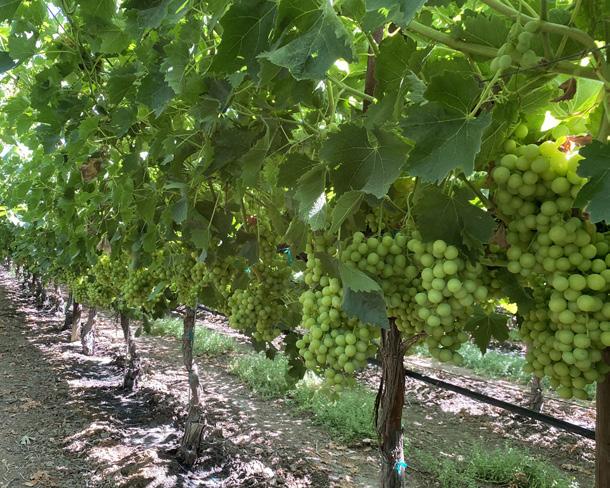
Studies were conducted under field conditions in California and Oregon and in potted systems in South Africa to track nutrient uptake, movement and distribution among vine organs at different phenological stages.
In terms of macronutrients, annual growth is a strong sink for N, phosphorus (P), potassium (K), calcium (Ca) and magnesium (Mg) between bud break and veraison. Required nutrients of shoots, leaves and clusters can be obtained from two pools: nutrients remobilized from permanent organs and those taken from soil. In mature vines, up to 50% of N and P in new growth can be supplied by the stored reserve in trunks and roots. On the other hand, less than 15% of K, Ca and Mg are remobilized from the reserve, since only a small
percentage of those nutrients can be recycled during leaf fall. Clearly, nutrients obtained from the soil still account for a large portion of required nutrients, even in the mature vines. Young vines have less nutrient reserve than older vines, and thus rely more on nutrients supplied by root systems. Nitrogen uptake peaks between bud break and bloom, while uptake of other macronutrients usually reach the max between bloom and veraison. Nutrient uptake also takes place after harvest
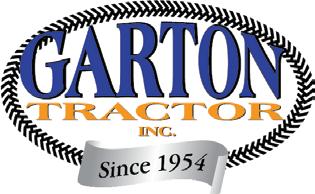





Political commentator and Fox News co-host, Jesse Watters, will be the headliner at a premiere ag event coming to the heart of the Central Valley on November 2. My Ag Nite, hosted by Jason Scott, CEO of JCS Marketing, Inc., will bring together industry professionals and conservative dignitaries to celebrate all things California agriculture.
The dinner and gala will take place at the International Agri-Center in Tulare, Calif., and is expected to sell out. Guests will have access to an exclusive trade show showcasing innovative farming solutions, and the opportunity to network and forge connections within the industry.
Scott said he sees the night as a way to bring those who have a stake in agriculture together in one place to celebrate the industry and to wind down and enjoy like-minded solidarity following the stresses of the busy harvest season.
“We’re bringing a diversified group of thought leaders together to celebrate leadership in agriculture,” he said.
Scott is especially excited about the event being able to present a rare, in-person opportunity to hear from a political commentator of Watters’ caliber that will appeal to the conservative farming community. Watters’ notoriety has skyrocketed since he took over for former Fox News commentator, Tucker Carlson, who left the network earlier this year.
The chance to see Watters speak isn’t likely to come around again to this
part of the state, Scott said, and will no doubt make the event memorable.
“We expect this to be one of the best events that we’ve ever put on or will put on,” Scott said. “If you want to attend something that’s different, unique, and special to agriculture, this is the one time you need to make time to show up.”
Scott's firm publishes both print and digital trade magazines. The publications include West Coast Nut, Grape & Wine and Progressive Crop Consultant. Scott's firms also hosts a growing website called MyAgLife, which highlights the diverse agriculture commodities of the West Coast. The site is also home to a daily and weekly podcast highlighting Central Valley ag issues and leaders.
Coming out of a post pandemic reality, Scott came up with the idea for My Ag Nite as a way to stimulate live events, he explained. Like the MyAgLife website and brand, he emphasizes the event being about agriculture as a whole, and not focusing on any one commodity.
“We wanted to do something unique in the industry, for the industry, and we wanted to provide something for the MyAgLife brand,” he said. “The idea behind it is that we celebrate agriculture and our conservative values in the industry.”
Scott says that while he tends to leave politics out of his publications and marketing, he sees My Ag Nite as a way for those who have a stake in agriculture to be able to talk about the issues that affect them first hand—with

the successes and failures of those issues so often being determined by politics.

“I feel like agriculture is in a place where it’s time to get back to basics, it’s time to celebrate a lot of the things we have in common, and be able to come together and talk about it for an evening,” he said.
Scott added that he wants people to walk away with renewed relationships, a better understanding of who ag is as an industry, and the challenges ag faces collectively, as a group.
“I hope attendees will walk away with a sense that not all is lost with conservative values and we don’t stand alone in that community,” he said
Tickets for My Ag Nite start at $150 per person and a number of upgraded ticket opportunities are also available, including a meet and greet with Watters, group table reservations, and trade show booth space. Tickets and further information can be obtained through www.myaglife.com/myagnite. Ag media inquiries only can be directed to the JCS Marketing Office (559) 352-4456. No outside media outlets beyond agriculture.
JCS Marketing has a rich history in providing marketing services tailored to the agricultural industry. With a deep understanding of the unique needs and values of the ag community, they are committed to fostering connections and driving success within the industry.
when nutrients are available in the soil and weather conditions are favorable.
The uptake and distribution of micronutrients is less understood as compared to macronutrients. Dr. Paul Schreiner, scientist at USDA-ARS, studies the budget of micronutrient in young and older ‘Pinot noir’ vines in Oregon’s Willamette Valley. In young vines, boron, zinc, manganese and copper were taken between bud break and harvest, with the peak of uptake occurring between bloom and veraison. The uptake and allocation of micronutrients appears less consistent in mature vines.
Please note that research findings reflect vine nutrient budget under specific conditions and should be interpreted with caution. Factors like soil nutrient availability, irrigation practices, rootstock and scion combination and weather conditions have large impacts on nutrient uptake and allocation. Clearly, vine nutrient demand varies between vineyards. So, how should one determine whether fertilization is needed at a specific site?
Nutrient analyses of leaf blades and leaf petioles at bloom and veraison are indicators of vine nutrient status. Many testing labs provide the comparison of
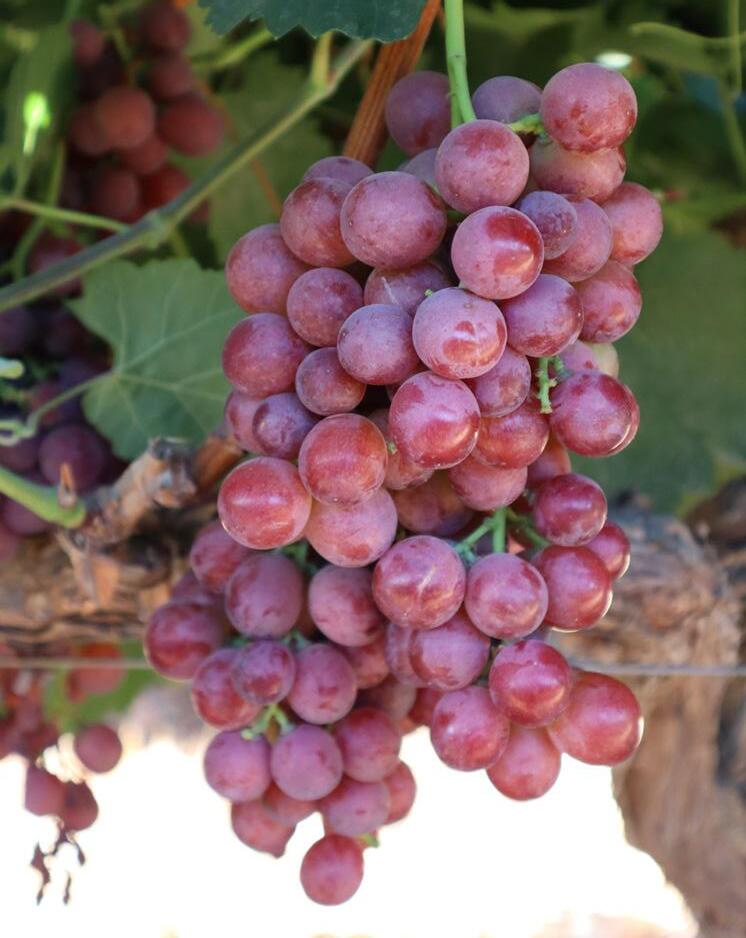
leaf nutrient concentration to the normal range for each nutrient.
We recommend growers not relying solely on numbers on lab results to make fertilization decisions. First, variability in vine nutrient requirement is expected between vineyards and across seasons. Even if the tissue nutrient concentration of a vineyard is slightly below the given normal range, it does not mean vines surely experience nutrient deficiency. Second, normal ranges of leaf nutrients are estimated in experiments where vines received a specific nutrient at different rates and had its concentration over a wide range of leaf tissues. Given the difference in experimental setup, the normal range determined can vary between studies. Thus, the normal range for nutrients should be used only as references when it comes to interpreting vine nutrient requirements. Historical nutrient data, vine growth and production goals are important to consider. For example, fast-growing canopies may have lower leaf N concentration, especially in newly expanded leaves, but does not mean that vines require N fertilization. Instead, rapid shoot growth often indicates ample N and water availability in the soil.
In vineyards where fertilization is needed, growers and CCAs often ask me about the amount, formula and application timing of fertilizer. Rather than providing generalized answers for those questions, I would like to share some tips. Please feel free to reach out for questions related to your vineyards.
About 3 lb N, 0.5 lb P and 5 lb K are removed from a vineyard with each ton of harvested fruit. Many would use those numbers to calculate how much fertilizer is needed to compensate the loss during harvest. In reality, supplementing vines only with nutrients removed from the vineyard may not be sufficient. For instance, data from western Oregon showed that young ‘Pinot noir’ vines acquired 12.5 lb N, 3 lb P and 25 lb K per acre via uptake with the crop level at 2.0 ton/acre.
Compost is an affordable, slow-releasing fertilizer. Applying compost in the spring supplements vines with nutrients, boost soil microbial activity, improves soil water penetration by aggregation and enhances water holding capacity. Increasing soil organic matter is good practice for soil health in general. Soil pH plays key roles on nutrient availability. Most nutrients become more available in soils with neutral pH. Regular soil sampling and testing can help with managing and adjusting soil pH if needed.
If nutrient deficiency is observed late in the season, immediate fertilization may not alleviate the symptoms. It is because the period when nutrient deficiency becomes evident would not be coincident with the period when nutrient uptake peaks. Making applications at the right timing in the following season may be more effective on correcting deficiency.
Even though vines obtain nutrients mainly from the soil by roots, foliar application can be an additional tool to supplement vines with nutrients. In the past, we successfully increased fruit N at harvest in wine grapes by applying urea to foliage between fruit set and veraison. Foliar application of P and Mg was found to reduce leaf symptoms in wine grapes. Some PCAs suggest foliar Ca and Mg sprays between bloom and veraison can increase berry firmness and reduce powdery mildew occurrence in table grapes.
Applying fertilizers in small doses may improve fertilization efficiency in vineyards with shallow root sys tems. Theoretically, frequent fertilization with lower doses allows roots to better catch nutrients and reduce leaching.


Araujo FJ and Williams LE. 1988. Dry matter and nitrogen partitioning and root growth of young fieldgrown Thompson Seedless grapevines. Vitis 27:21-32.
Conradie WJ. 1980. Seasonal uptake of nutrients by Chenin blanc in sand culture: I. Nitrogen. S Afr J Enol Vitic 1:59-65.
Conradie WJ. 1981. Seasonal uptake of nutrients by Chenin blanc in sand culture: II. Phosphorus, potassium, calcium and magnesium. S Afr J Enol Vitic 2:7-14.
Schreiner RP, Scagel CF and Baham J. 2006. Nutrient uptake and distribution
in a mature ‘Pinot noir’ vineyard. HortScience 41:336-345
Schreiner RP. 2016. Nutrient uptake and distribution in young Pinot noir grapevines over two seasons. Am J Enol Vitic 67:436-448
Comments about this article? We want to hear from you. Feel free to email us at article@jcsmarketinginc.com
TriClor is chloropicrin based and can be used as a standalone or as a complement to Telone® depending on your orchard redevelopment needs. When targeting soil borne disease and nematodes, TriClor and Telone® can be applied in a single pass. This reduces application costs, promotes early root development, and improves soil health. For more information about TriClor and Telone or to schedule an application contact TriCal, Inc.
The European Union (EU) has a deadline of Dec. 8, 2023 to add nutritional and ingredient labeling to wine, information that will be displayed on the bottle in the form of a QR code. Labels will list both ingredients and processing aids, said Monika Christmann, the former head of the International Organization of Vine and Wine (OIV), at the recent American Society of Enology and Viticulture (ASEV) conference held in Napa.
These QR codes will apply to any wines imported into the EU from the U.S. (or elsewhere).
The EU looks to OIV to set the standards. OIV rules require a unanimous vote to create standards, ensuring all 51 member countries (not including the U.S.) are aligned.
“As of December this year, we have to not only put on the calorie stamp, but also the question of what is an additive and what is a processing aid on the label,” Christmann said. This is problematic because the industry has repeatedly told
consumers wine is natural, she said.
“For too long, we have told the consumers wine is a natural product,” she said. “And now we have to explain why we are using techniques. So that’s a little bit of a homemade problem.”
It may also impact the way wines are made, she said, as producers will need to state additives and processing aids on the QR code and may modify winemaking practices to omit listing additives they previously used.
The industry lobbied for QR codes rather than bottle labeling nutritional and ingredients information.
“If you’re an exporter, you’re going to have to have different labels for the EU than you will in the U.S.,” said Michael Kaiser, executive vice president and director of government affairs for the wine industry lobbying group Wine America.
In the U.S., the Alcohol and Tobacco Tax and Trade Bureau (TTB) announced last fall that mandatory
nutritional labeling in wine is coming, but experts are unable to predict when this might happen or when research for rulings will begin.
Christmann said consumers will be interested in statements about additives, and one of the most common is acid additions. “...what is the consumer going to say about it? Are they accepting that? Do they really like that?...that will impact our winemaking dramatically in the future.”
In 2022 the Wine Market Council in the U.S. surveyed 1,000 wine consumers in the U.S. to better understand how consumers view wine labeling. The survey found 52% of respondents were looking for nutritional info.
That ties into trends in both the U.S. and the EU, where consumers are seeking greater transparency about food and beverages they consume. Kaiser said the lack of transparency can be a turnoff for the market segment the wine industry is most rapidly losing (younger drink-
Wine Market Council research investigated how often consumers of wine view ingredient lists on bottles that have them (courtesy Wine Market Council, Ingredients & Nutrition Labeling Research 2022.)

One-third of consumers that at least sometimes review nutrition labels on alcoholic beverages including wine are checking for calorie content (courtesy Wine Market Council, Ingredients & Nutrition Labeling Research 2022.)


Nutritional and ingredient labeling to wine, information that will be displayed on the bottle in the form of a QR code, will soon be required under new EU rules.

ers), and he added it could be a factor in the trend toward forgoing alcoholic consumption altogether or switching to non-alcoholic beverages.
In a 2023 survey, Wine America found 63% of its member respondents were opposed to disclosing ingredient information. In addition, 80% of wineries responding expressed negative feedback about the prospect of the U.S. following the EU example of requiring QR codes.
That does not align with what consumers want, according to Wine Market Council research which found the slight majority (52%) were looking for nutritional info. The most sought-after data was calories. In addition, 28% were looking for added sugar. Another 11% looked for data on carbohydrates. Women were more likely to look for sugar content (31%) than men (23%).
Wine Market Council research showed consumers generally expected wine to have more sugar than it does.
Presented with a generic nutritional wine label, showing 123 calories, 4g of carbohydrates, 1g of sugar and 0g of fat and protein, consumer reactions were varied.
Overall, consumers generally expected wine to have more sugar than it does.
On the caloric scale, 47% had a positive reaction to the statement that the wine had 123 calories, 17% a negative reaction and 36% were neutral.
The study looked at consumer perceptions of which alcoholic beverages had the most calories, carbs, sugar and artificial ingredients. 47% thought wine had sugar and 22% thought wine had carbohydrates.
After seeing the sample labeling information, their reactions changed. The highest positives were that 63% had a positive reaction to the labeling that showed there was only 1g of sugar and
74% had a positive reaction to the 0g fat label.
The study respondents were split 50/50 between core wine drinkers (once per week or more often) and marginal wine drinkers (less than once a week). The respondents were 60% female and 40% male. One-third were 21 to 39 years of age, one-third 40 to 59 and one-third 60 and older.
Additional Wine Market Council research in the U.S. showed consumers do not feel comfortable with listed ingredients with chemical names. The study found the QR codes were more popular with the younger generation of consumers.
Comments about this article? We want to hear from you. Feel free to email us at article@jcsmarketinginc.com
When thinking about sustainability, people often focus on environmental practices. Heightened concerns over resource issues such as water quality and availability, greenhouse gas emissions and soil nutrient depletion have inspired consumers to seek out businesses that use practices that are less demanding on and harmful to our blue planet.
While combating climate change and environmental degradation are certainly good enough reasons to support sustainable agricultural systems, many consumers will be pleasantly surprised to learn that sustainability goes beyond protecting the ecosystem. Sustainability puts a heavy emphasis on social equity. If you are wondering what it means for a
business to practice social responsibility, look no further than the sustainable winegrowing industry.

The sustainable winegrowing community knows that people are our most valuable resource. Within the business, this includes the people who plant, care for, harvest, crush, ferment, bottle and pour the wine. Outside the business, it means the larger social systems in which the business exists, including neighbors and communities. Sustainable winegrowers put conscious care into protecting human resources.
In the eyes of many Americans, being a good employer is one of the most important attributes of a responsible company (Cone Communications 2017).
Sustainable winegrowing businesses invest care and resources into their workforces by offering fair wages and benefits, safe and ethical working conditions, regular safety trainings, opportunities for education and emphasizing diversity and inclusion in their hiring processes. By creating an environment that encourages wellbeing and development, these companies foster strong, dependable workforces.
77% of consumers are motivated to purchase from companies committed to making the world a better place (Aflac CSR Survey 2019). There are several ways a business can use its resources to give back and in turn support the people and communities who make its success possible.
Sustainable winegrowers stay engaged and in tune with their communities by creating communication plans and participating in community forums. They give back to their communities through charitable donations including volunteer time and funds to local organizations. Many brands invite communities to their farms to participate in events designed to educate the community on resource issues and sustainable farming practices. Consumers can support these virtuous endeavors by choosing to shop their values and buy from a business that does good.
All of this is great news for the nearly 46% of U.S. regular wine drinkers who say they will always choose a sustainable wine when given the choice (IWSR 2022). The mindful shift toward

supporting sustainable businesses and products has been observed over the past several years (Simon-Kutcher & Partners 2021; NielsenIQ 2021). IWSR’s latest findings from tracking consumer interest and attitudes toward alternative wines shows that the proportion of regular wine drinkers who are even willing to pay more for wine that was made sustainably has significantly increased over the past year (IWSR 2022).
By opting for a sustainably produced wine, wine enthusiasts are enforcing the socially responsible practices that the wine brand engages in. They can enjoy the good feelings that come from knowing they are supporting a company that treats its employees with care and respect and extends their good work to uplift their community.

Conscientious consumers can look for wine labels that showcase their social responsibility right on the label. For example, consumers of Vina Robles’ the Arborist Red Blend can feel good knowing they are helping plant trees with every bottle they purchase of this dynamic red blend.
In 2017, a unique partnership was formed between Vina Robles, a SIP Certified sustainable winegrower in Paso Robles, Calif., and two non-profit environmental conservation organizations: One Tree Planted and the Arbor Day Foundation. This partnership is a natural extension of the winery’s passion for trees and sustainable viticulture. Vina
Broad spectrum protection against sucking & chewing insects & mites
Flexibility of application with 0-Day PHI
Multiple modes of action: Ingestion, Feeding Interference
Broad spectrum protection against sucking & chewing insects
Excellent rotational partner with Venerate XC
Multiple modes of action: Repellency, Ingestion, Reproduction Disruption
“Wine brands have the opportunity to create an emotional connection with their customers by sharing stories about the specific things their brand does to be sustainable and why those practices are important.”
– Beth Vukmanic, Vineyard Team
ContinuedfromPage23
Robles has created a wine to embody these organizations’ shared belief that planting trees is the key to preserving our planet.
The oak tree depicted on the bottle’s label represents the Legacy Oak, an oak tree that took root on Vina Robles Estate’s Jardine Vineyard over 300 years ago.
The wine itself is dedicated to the winery’s founder, Hans Nef, and is named for the arborist who saved the tree from its declining health in 2014.
The trees planted through this partnership have been planted all around the world. “Our current tree count is over
35,000 trees,” said Alyssa Krichevsky, director of marketing at Vina Robles. “We hope to bring more attention to the work and host our own community event in the future.”
Socially responsible initiatives like Vina Robles’ the Arborist program allow consumers to contribute to a greater cause while they enjoy a glass of wine. This is a win for the brand, consumers and planet.
If your wine business practices social responsibility and other sustainable practices, share this valuable information with your customers. Communicating your business’s care for social issues is a great way to capture the attention of the 70% of consumers who want to know what the brands they support are doing

...in today’s world, sustainability can mean almost anything, and we’re seeing a consumer group that wants to be educated and wants to know exactly what is going on with sustainable wine production."
- Kathleen Kelley, The Pennsylvania State University
to address social and environmental issues (Certus 2019).


Helping wine consumers understand specific sustainable practices can also increase a winery’s sales (Kathleen Kelley, The Pennsylvania State University, 2021).

In a recent study, two of Pennsylvania State University’s Kathleen Kelley’s colleagues, Michela Centinari and Justine Vanden Heuvel, determined that under-vine vegetation, or cover crops, can prevent erosion and soil runoff, nutrient leaching and excessive vine vegetative growth. Kelley wondered if promoting this sustainable farming practices could be part of a marketing strategy to sell more wine.
To test this theory, Kelley sought to characterize several wine consumer groups that were “likely” to sample wine from vineyards using cover crops. The findings, published in the International Journal of Wine Business Research, found 72% of 956 wine consumers from the mid-Atlantic region surveyed were willing to pay $18.99 for a 750-ml bottle of wine, which included a $1 surcharge to cover associated sustainable production costs including cover crops. Additionally, 26% indicated they would be willing to pay $20.99.
It’s important to note for the participants in Kelley’s study, simply hearing a wine brand acted sustainably wasn’t enough; it was learning the importance of specific sustainable practices that increased customers’ willingness to pay more for a sustainable wine. As Kelley said in her ‘Cover crops make vineyards more sustainable; strategy can be marketing tool ’ article, “...in today’s world, sustainability can mean almost anything, and we’re seeing a consumer group that wants to be educated and wants to know exactly what is going on with sustainable wine production. So, being descriptive about what it actually means to include cover crops in a vineyard is a way to be attractive to them.”
We know that the proportion of regular wine drinkers willing to pay more for sustainable wine has significantly increased in the past two years. Vineyard Team’s Executive Director Beth Vukmanic said, “Wine brands have the opportunity to create an emotional connection with their customers by sharing stories about the specific things their brand does to be sustainable and why those practices are important.”
Don’t miss the next issue of the Sustainable Story Series to learn how one Paso Robles winery designed their entire operation to help protect California’s top resource concern: water.
Comments about this article? We want to hear from you. Feel free to email us at article@jcsmarketinginc.com
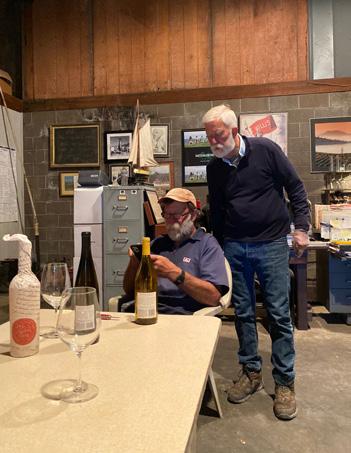
Nestled high up in the Spring Mountain District of California’s northern Napa Valley, Smith-Madrone Vineyards is unique in many ways when it comes to growing grapes and making wine.
There aren’t many wineries in the state that sit at around 2,000 feet of elevation, and certainly less that are dry farmed
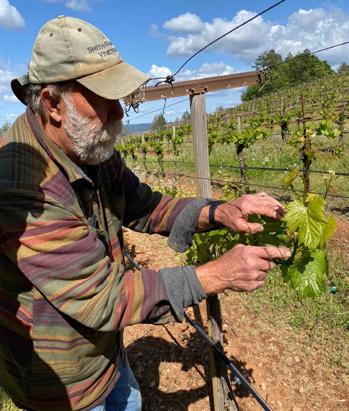

like Smith-Madrone. Winemaker Stu Smith, who studied viticulture and enology at UC Davis and founded the vertically integrated operation with brother Charles, considers winegrapes grown in the mountains to have character, flavor and interest, qualities that convinced him to plant in Smith-Madrone’s location. The winery’s name comes from Smith’s last name com-
bined with the name of the predominant tree on the ranch, the Madrone, an evergreen with a red-brown trunk and branches. The operation is dry farmed and since 2017 has received little to no irrigation.
Today’s winegrape industry sees much of its product grown in the Valley, but
Promote root growth and improve soil
Improve nutrient absorption efficiency and fertilizer utilization

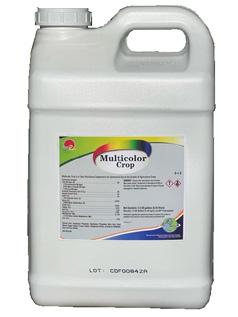

Increase production and improve quality
Drought and heat resistance
Cold and waterlogging resistance
Acid and alkali resistance
Disease resistance
In addition, you can see it achieve:
Increased fruit sugar content
Increased fruit density
Improved peel color and texture
 Multicolor Sweet
Multicolor Crop
Multicolor Sweet
Multicolor Crop
before this practice took off, Smith said grapes were mostly grown in mountainous regions and takes pride in the location he’s been fortunate to produce in. He also acknowledged major differences in growing on a mountain vs. in a valley, including the ability to use certain equipment, water availability, permitting and surrounding wildlife among other challenges.
Smith-Madrone currently produces wine grown from grapes of Chardonnay, Riesling, Cabernet Sauvignon, Cabernet Franc, Merlot and Petite Verdot varieties.

Smith sat down with Grape and Wine to share his experiences at Smith-Madrone from 1971 to present day.
The history of the property goes back to 1880, when George Cook planted a fair number of olive trees and cleared the forest to plant a vineyard. He then went to San Francisco and applied for the Homestead Act and was granted the property.
That vineyard was abandoned around that time, Smith said, as were most of the vineyards in the mountains, as a result of grape phylloxera, a root-feeding insect.
Smith visited the property when it had regrown into a forest and closed on it in 1971. In June of the same year, he acquired a logging permit to reclaim the vineyard from the forest and start planting.
“We had to clear the vineyard, we had to pick up all the rocks and the roots,” Smith said. “Just smoothed it out, we just picked up, picked up, picked up.”
In 1972, planting started. “We planted five acres each of Cabernet Sauvignon, Pinot Noir, Chardonnay and Riesling,” he said, although the vineyard’s current acreage no longer consists of Pinot Noir as it was phased out and grafted to Chardonnay in the 1980s.
Grapes
Vines are planted in Smith-Madrone’s
vineyards on slopes with varying sun exposure depending on variety. Smith noted this orientation heavily contributes to wine quality as different varieties grow best with more or less sun exposure.
“The Chardonnay, which was Pinot Noir at the time, was planted out in front of the winery, and it went around a slope,” he said. “It was a northeast-facing slope, and it would get the least amount of direct sunlight because it would be a fairly obtuse angle for the sun. I decided to plant the Pinot Noir there because Pinot Noir needs less sun than anything else.
“Just across an avenue was an area that was facing more east,” Smith continued. “I put the Riesling there because it needed more sunlight than Pinot Noir.”
The vineyard also has a flatter portion with good sun exposure to the southeast where Smith planted the Cabernet Sauvignon.
The original vineyard was hand-watered in its first year and dry farmed in subsequent years, and any new plantings have followed suit with this strategy.
Dry farming as a technique has been discussed within the ag industry due to recent severe drought years in California and certain crops being tolerable to it, but the practice is still infrequently used.
Drip irrigation wasn’t common practice either when Smith initially planted, so the intention from the beginning was to dry farm, and for the most part, the vineyard has stuck to it. Drip was installed in the vineyard later but ripped out in the mid-1980s. However, due to drought concerns, any new planting in the vineyard today, Smith said, has drip installed.
“When I say dry farming, we’re not 100% anal about this,” Smith said. “Unlike back in the mid-80s with the drought, we didn’t and aren’t going to tear out the drip irrigation this time around because we just don’t know what climate change is going to bring us.
“We don’t have a lot of water, and we have to be very careful about what we do have, but a number of our blocks haven’t had water [applied] in many years.”
As with the orientation of the vineyard and its varying sun exposure, Smith
believes this water strategy contributes to grape and wine quality, noting the vines go from a vegetative cycle to a ripening cycle in a more natural fashion. “The vines understand what’s going on,” he said.
It should be noted that these methods produce a smaller crop all around with a different fruit set, but that is exactly what Smith is striving for. “We don’t want big, fat, juicy, watery [grapes],” he said. “We want small berries that struggle to exist and have lots of concentrated flavors.”
Wine
Smith-Madrone follows what Smith called a “Eurocentric” approach to winemaking, which believes in good acidity, balanced complexity, finesse, elegance and flavor layering. By definition, if any one of these pillars is more dominant than another in the final product, the wine is considered “singular.”
“What we want is all kinds of interesting flavors that balance one another and create a wine that is hedonistic,” Smith said, stressing the goal is not to make a Pepsi or a Coca-Cola but rather an end product that is more refined.
In terms of why Smith-Madrone produces their current selection, which includes Chardonnay, Riesling, Cabernet Sauvignon, Cabernet Franc, Merlot and Petite Verdot, Smith said it is mostly a matter of preference and the ways in which the winery has been able to advance its wine composition over the years.

Smith takes pride in the experience Smith-Madrone offers to visitors, who can visit with him and Charles directly during tours. The two brothers share decades of combined viticulture and enology experience.

“You’re having a tour and tasting with a person who’s been doing this for decades and can answer almost any question out there that someone has,” Smith said, “and that is something you cannot get at most larger wineries. Any questions you want to ask, we will stay with the group or the person until they’re done asking questions and we will give the very best straight scientific answer that we know.”
The bulk of the winery is nestled against an alley of olive trees and overlooks most of the Chardonnay vineyard and the floor of the Napa Valley. “The property is beautiful,” Smith said.
Comments about this article? We want to hear from you. Feel free to email us at article@jcsmarketinginc.com
Asuccessful entrepreneur and pioneer in biopesticides, Pam Marrone is the co-founder and executive chair of the Invasive Species Corp. and Invasive Species Foundation. A thought leader with deep experience in the ag biologicals industry, she successfully brought multiple science-based products to market and scaled two agbio companies from founding to a consistent high growth revenue stage.
Marrone also mentors entrepreneurs and promotes education on ag biologicals through speaking and writing.
In 2010, she won an IPM Innovator award from the California Department
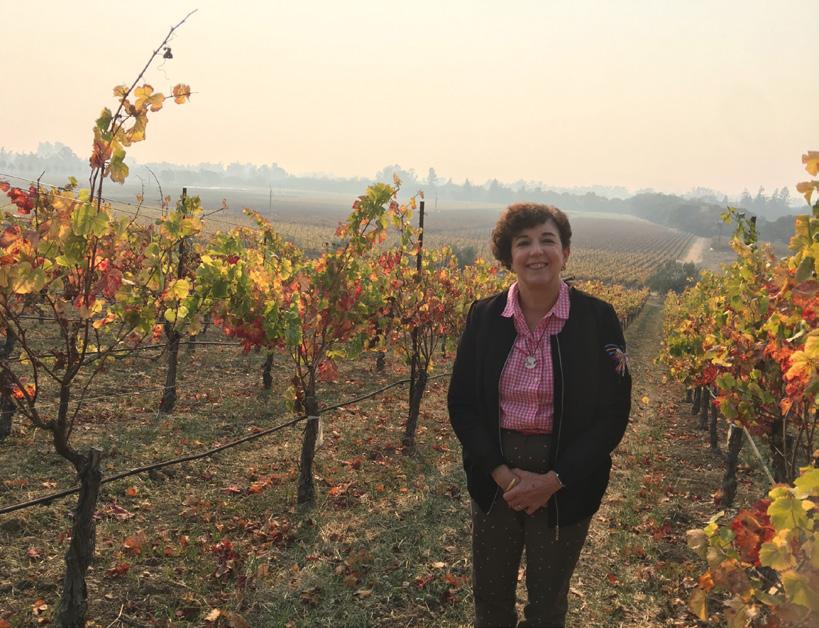
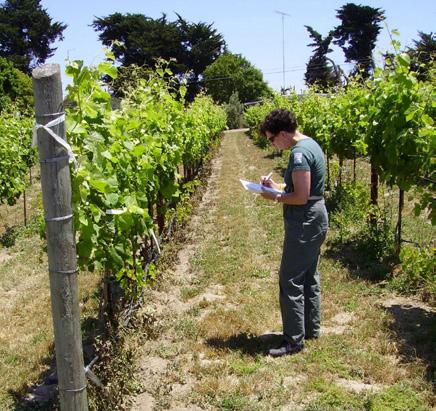
of Pesticide Regulation (DPR) and recently served on DPR’s committee on Sustainable Pest Management, creating a new roadmap and recommendations. She also serves on the board of the Foundation for Food and Agriculture Research.
In 2019, BioAg World honored her with a Lifetime Achievement Award for Contribution in Biopesticides.
What are biopesticides?
They’re naturally occurring microorganisms like bacteria and fungi and some extracts of plants and other natural materials that are nontoxic to humans and the environment.
And how do you find them?
Microorganisms live everywhere, outdoors in the soil, on flowers, on your body, on your feet, and so you literally can find them anywhere. Companies looking for and developing new drugs look to the rainforest, and for areas of high biodiversity to find new drugs. It’s the same with things that kill pests.
So you look for areas where there’s a little battle going on between the different microbes, and the ones that win out tend to be the ones that probably have pesticidal properties. A dry creek bed, where it’s wet part of the year and dry part of the year, so the microbe has to be pretty tough to survive the different conditions.
How did you get started in this field?
I was actually hired to start up a new program at Monsanto in the 1980s, looking for nonchemical ways to control pests.
I was given pretty much free rein, and I set up a national products screening program, like we’re doing now at Pro Farm Group (the new company name, after the sale to Bioceres Crop Solutions), just screening microbes looking for ways to control pests. And that was great fun.

We screened over 100,000 microorganisms, looking to control pests, plant pathogens and weeds. And Monsanto decided they were going into genetic engineering of crops, and so that’s what they wanted me to switch to, and I really preferred screening the microbes. I fell in love with that.
Then I got a call from a Danish company, Novo Nordisk. They were looking for someone to start up a new company, looking for testing microbes against pests. And I said, ‘Wow, that’s exactly what I want to do,’ so I left Monsanto and started up Entotech here in Davis, [Calif.]
And then they sold us to a large competitor in 1995. And that’s when I started AgraQuest, which I left in 2006, and then started up Marrone Bio Innovations in 2006.
Where did you find the organisms in these products?
We found the Bacillus in Stargus® in a rice field in northern California. Grandevo®, which we licensed from USDA-ARS, was found under a hemlock tree in Maryland, and we discovered Venerate® from a Buddhist Temple gar den in Japan.
Are growers using these products and find them effective?
Yes they are, and our products have grown quite rapidly. But it is important to know how best to use them as they are not curative synthetic chemicals and need to be applied before the buildup of the pest or pathogen.
Are there alternatives to glyphosate yet?
Not yet on the bioherbicide side. The products for organic growers are typically burndown and need to be reapplied, like those from capric and caprylic acids by Certis and Westbridge.
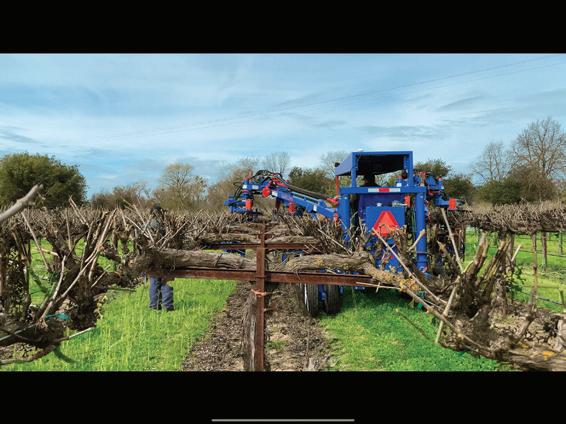
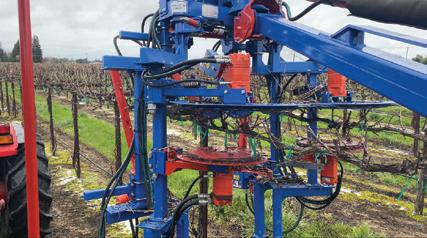
What are the next problems you’re hoping to solve to help growers?
I was working on three products for weed control while leading Marrone Bio. Bioceres has indicated it wants to complete their development.
In the new company that I recently co-founded, Invasive Species Corporation, we are setting up a bioherbicide screening platform. There are very few bioherbicides out there because chemical herbicides are so inexpensive. It is
just very technically challenging to find a bioherbicide that will compete. But those types of grand challenges are what I like to tackle, and I am convinced with the new scientific tools we have today our team can quickly find some effective and cost-effective bioherbicides.
Comments about this article? We want to hear from you. Feel free to email us at article@jcsmarketinginc.com

Activate your plants’ natural defense systems.
With the first biological plant activator in a new class (FRAC P6), you can manage disease before it starts. LifeGard®, with active ingredient Bacillus mycoides isolate J (BmJ), triggers plants’ natural immune defenses, causing metabolic responses that resist the infection and development of bacterial, viral and fungal diseases.

Key Diseases Controlled:
Black Rot Downy Mildew Powdery Mildew Phomopsis
Learn more about LifeGard by visiting www.LifeGardBPA.com
